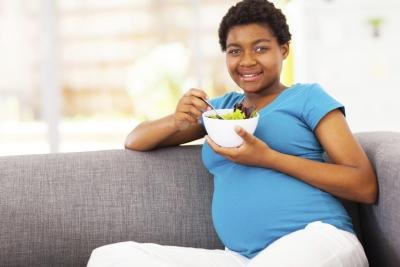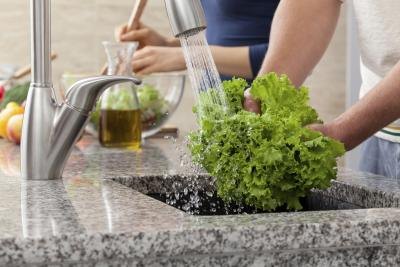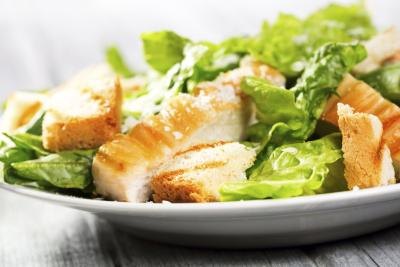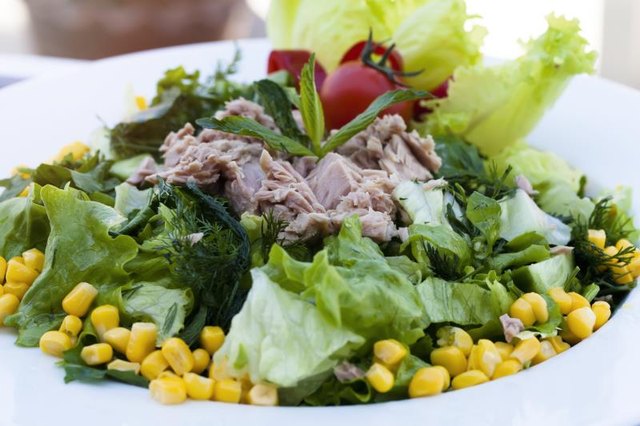
Overview
Salads are an excellent way to take in the nutrition both a mom-to-be and her unborn child need during pregnancy. Creating dishes using fresh vegetables, whole fruits, nuts, seeds, whole grains and fish or lean poultry allows them to access vitamins, minerals, protein and essential omega-3 fatty acids but because of the fetus' susceptibility to food-born infections a bit of extra care is necessary during salad preparation. Common foodborne infections that can come from contaminated fruits, vegetables or cheeses include cyclosporiasis, E. coli, hepatitis, listeriosis, novoviruses or gastroenteritis, salmonellosis and bacterial dysentery, according to the U.S. Food and Drug Administration.
Safe Lettuce Salads

Salads often start with dark, green leafy vegetables and all lettuces are safe after washing but not all are equally beneficial. To gain maximum nutritional value, salad greens such as arugula, kale, spinach, romaine, red lettuce and radicchio should be selected over bib and iceberg varieties.
To make lettuce greens safe, it's necessary to clean the greens and to use them with in a few days of being purchased. Start by washing hands and all surfaces used to prepare the salad in warm, soapy water, Then wash the greens, leaf by leaf, under running water and pat them dry with clean paper towels or spin them in a machine made for this purpose. After cleaning, store the greens, covered in a refrigerator set at less than 40 degrees Fahrenheit. These recommendations, made by the National Institutes of Health are designed to prevent exposure to foodborne infections that can cause serious complications in pregnancy.
To make lettuce greens safe, it's necessary to clean the greens and to use them with in a few days of being purchased. Start by washing hands and all surfaces used to prepare the salad in warm, soapy water, Then wash the greens, leaf by leaf, under running water and pat them dry with clean paper towels or spin them in a machine made for this purpose. After cleaning, store the greens, covered in a refrigerator set at less than 40 degrees Fahrenheit. These recommendations, made by the National Institutes of Health are designed to prevent exposure to foodborne infections that can cause serious complications in pregnancy.
YOU MIGHT ALSO LIKE
Multi-Vegetable Salads

Many other vegetables can be added to a salad as well and according to the Organization for Teratology expectant moms need not feel obligated to buy more expensive organic produce. These scientists state that commercial-grade pesticides used in farming hold no threat of harm to an unborn child, especially after the vegetables are washed.
Tomatoes, include the grape and cherry varieties, that can be added whole after washing in running water and drying and the larger forms are equally tasty sliced or cut into small pieces.
Carrots and the Mexican vegetable, jicama simply need to be washed and peeled before being added to the salad but broccoli, cauliflower and celery should chopped into bite size pieces, so that dirt can't hide in their crevices during washing. After this additional preparation, they add fiber and crunch to any salad.
Winter vegetables like parsnips, turnips and beets extend access to fresh, locally grown produce year-round. These should be washed and peeled before being cooked then they can be added warm or cold to the salad.
Tomatoes, include the grape and cherry varieties, that can be added whole after washing in running water and drying and the larger forms are equally tasty sliced or cut into small pieces.
Carrots and the Mexican vegetable, jicama simply need to be washed and peeled before being added to the salad but broccoli, cauliflower and celery should chopped into bite size pieces, so that dirt can't hide in their crevices during washing. After this additional preparation, they add fiber and crunch to any salad.
Winter vegetables like parsnips, turnips and beets extend access to fresh, locally grown produce year-round. These should be washed and peeled before being cooked then they can be added warm or cold to the salad.
Salads with Meat, Fish or Eggs

Protein is important for healthy fetal growth and adding fish or nuts to a salad also increases the amount of omega-3 fatty acids which promote the development of s healthy and body even before birth but for safety eggs, fish and any meats added to salads must be cooked completely. The National Institutes of Health recommends cooking raw eggs for 10 minutes and ensuring red meat and poultry reaches a temperature of 165 and 180 degrees Fahrenheit, respectively.
Since raw eggs must be avoided during pregnancy salad dressings should be prepared with out them and at restaurants women should ask to be certain they are not in any salad sauce.
There is concern among scientists about the levels of methyl-mercury contamination in the world's water supply and its ability to damage the unborn child. Because swordfish, shark, king mackerel and tilefish are often found to have unacceptable levels of this dangerous chemical pregnant women are advised by the US Food and Drug Administration to avoid them entirely and to limit tuna to 6 ounces a week.
Finally, to prevent Listeria infection only cheese made from pasteurized milk should be added to salads or eaten in any manner during pregnancy. The Centers for Disease Control and Prevention report that the risk of getting listeria is 10 times greater for pregnant women than for the general population.
www.livestrong.comSince raw eggs must be avoided during pregnancy salad dressings should be prepared with out them and at restaurants women should ask to be certain they are not in any salad sauce.
There is concern among scientists about the levels of methyl-mercury contamination in the world's water supply and its ability to damage the unborn child. Because swordfish, shark, king mackerel and tilefish are often found to have unacceptable levels of this dangerous chemical pregnant women are advised by the US Food and Drug Administration to avoid them entirely and to limit tuna to 6 ounces a week.
Finally, to prevent Listeria infection only cheese made from pasteurized milk should be added to salads or eaten in any manner during pregnancy. The Centers for Disease Control and Prevention report that the risk of getting listeria is 10 times greater for pregnant women than for the general population.

























